Abstract
This paper compares two electronically controllable solutions of triangular and square wave generators benefiting from a single IC package including all necessary active elements (modular cells fabricated in I3T 0.35 µm ON Semiconductor process operating with ±1.65 V supply voltage). Internal cells are used for construction of building blocks of the generator (integrator and Schmitt trigger/comparator). Proposed solutions have adjustable parameters dependent on the values of DC control voltages and currents. Attention is given to the mathematical expressions for the advantageous tunability of these generators. Theoretical mathematical functions comparing the standard linear formula with special expression for the frequency adjustment are evaluated and compared with experimentally obtained results. Mathematical functions prove that the proposed topologies improve efficiency of tunability and reduce overall complexity of both generators. Features of proposed solutions were verified experimentally. Both single-parameter tunable designs target on the operation in bands from tens to hundreds of kHz (from 13 kHz up to 251 kHz for the driving voltage between 0.05 V and 1.0 V for the first solution; from 12 kHz up to 847 kHz for the driving current between 5 µA and 140 µA for the second solution). A comparison with similar solutions indicates beneficial performance of the proposed solutions in tunability ratio vs. driving parameter ratio and also because simplicity of circuitry is low. The qualitative evaluation and comparison of parameters of both circuits is given and confirms theoretical expectations.
Keywords:
current conveyor; electronic adjusting (mathematic function); modular approach; operational transconductance amplifier; triangular and square wave generator; tuning MSC:
37M05
1. Introduction
Compactness and simplicity of functional (triangular and square wave) generators is very important for minimization of circuitry and also for effectivity of the design [1]. Modern active devices [2,3] may increase overall simplicity and bring interesting adjustable features to these generators (by the driving voltage or current). However, the actual number of active and passive elements cannot serve for evaluation of overall circuit suitability. Table 1 brings overview of recent development in the field of electronically tunable generators [4,5,6,7,8,9,10,11,12,13,14,15,16,17,18,19,20,21,22,23,24,25,26]. The design of these analog subsystems with requirement of a simple electronic adjustability of the repeating (oscillation) frequency or the duty cycle (see for example [1,4]) started with the simplest active elements. See solutions [4,5] for example. They provide a single electronically adjustable parameter such as operational transconductance amplifiers (OTA) [2,3]. The development continued with improvement of the features of these active elements and by introducing the adjustable elements with the capability of setting several parameters for driving of parameters of their applications in generators [6,7,8,9,11,12,14,15,16,17,18,19,20,21,22,23,24,25,26]. However, some of these active elements are hypothetical only. Their structures are usually constructed from individual transistor models and, then, final application is verified only by simulations with such structures [5,6,7,8,10,14,19,20,23,25]. Another possibility is to create an active device as so-called behavioral model consisting of several off-the-shelf commercially available standard devices [11,12,17,18,20,21,22,24,26]. High complexity of such structures is a key disadvantage in this case (5 IC packages or more are required [11,12,17,18,20]). In some cases, the number of these sub-elements is quite high [12,17,20] and it influences overall behavior of the circuit (overall power consumption increases; significant impact of real parasitic features of sub-elements such as bandwidth degradation, additional noise, offsets, etc.). It can be a typical issue for a discrete form of implementation using commercially available elements, but it is not valid in general. The bandwidth degradation is typical for these constructions but effects as noises are individual to the specific case of each discrete solution and cannot be directly generalized. In fact, integration of the system or its active parts and majority of components increases immunity of the system against these effects. In specific cases [9] the used active elements were fabricated in the form of an integrated circuit (IC) where all required operations are available within a single chip.

Table 1.
Comparison of the single-parameter electronically tunable generators providing triangular and square waveforms.
We compared solutions [4,5,6,7,8,9,10,11,12,13,14,15,16,17,18,19,20,21,22,23,24,25,26] and came to the following conclusions: (a) Very low number of solutions use DC voltage as driving force [9,12,14,15,16,25] for tuning or adjustment of additional parameters; (b) Most circuits employ DC current as a driving force 4–8,10,11,17–24,26]; (c) Only one generator was designed with completely integrated active circuitry [9]; (d) The number of active elements (without consideration of “complex behavior models”) is acceptable in all cases (2–3) but number of passive elements can be very high [9]; and (e) The ratio of the frequency range vs. the driving parameter range (evaluated as figure of merit—FOM in Table 1) is quite low (<0.8) in many of the reported results [5,6,7,8,9,10,12,13,14,16,19,20,21,23,24]. There are also solutions with excellent features for a wideband tuning [11,15]. However, these results were usually obtained by implementation of nonlinear dependence (inversely proportional [11] or exponential [15]) of parameters on driving force as well as solutions that require an increased number of active elements or IC packages [15] and passive elements [11]. A special type of tunability range extension has been observed in the case of [13]. This concept combined simultaneous multiparametric adjustment (voltage and current gain). Note that power consumptions are reported for simulated results (despite existing real experiments using off-the-shelf active elements—behavioral model of hypothetical active device) in most cases.
Based on this overview, there is a space for improvements in the view of complexity and tuning efficiency. The so-called modular approach [27,28] in development of the integrated building blocks for various purposes may help in this case with the design of adjustable functional generators. We prepared two novel solutions of generators using mutually interchanged order of active elements representing integrators and comparators. In both cases, tunability of the repeating frequency is achieved by the DC driving voltage or the DC driving current. The intentions of this paper (contribution of this work) can be summarized to:
- (a)
- introduction of two new and very simple solutions of electronically tunable generators employing single IC,
- (b)
- improvement of the tunability range and the tunability efficiency (ratio of the frequency range vs. the driving parameter range),
- (c)
- study of mathematical dependences of the frequency on the driving parameters and further consequences,
- (d)
- tests of tunability and efficiency for the nonlinear driving of the adjustable parameter,
- (e)
- comparison of expected and real (experimentally obtained) features of both circuits.
Organization of this paper is as follows: Section 1 compares previous works in the field, establishes important conclusions about possible improvements of state-of-the-art and introduces the main intentions of this work. Section 2 deals with the used active elements of modular concept (available as integrated cells on single IC package) fabricated for these purposes. Section 3 deals with two solutions of the proposed generators and includes theoretical analysis supplemented by real experimental results. Section 4 compares obtained features of both solutions qualitatively, and Section 5 concludes this work.
2. Active Devices—Integrated Modular Cells
Proposed generators use fabricated active elements available as cells of IC. The cells are accessible independently at pins of the IC package. Figure 1a shows schematic symbols of these devices. These cells (taken from the left side) are voltage multipliers having a current output terminal (based on core with bipolar junction transistors or CMOS transistors, i.e., abbreviated as BJT MLT and CMOS MLT), a single current controlled current conveyor of second generation (CCCII), and a voltage differencing differential buffer (VDDB). Details about these cells (internal structures and features) can be found in [29]. The detailed CMOS topologies are shown in Appendix A. The overall chip die area takes 1526 × 1526 µm where cells used in this work occupy 761 × 204 µm (CMOS MLT), 340 × 204 µm (BJT MLT), 616 × 204 µm (CCCII) and 430 × 204 µm (VDDB).
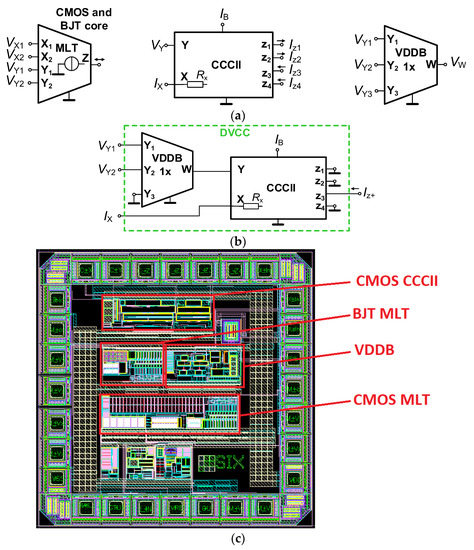
Figure 1.
Active cells fabricated in single IC package: (a) multipliers with current output terminal (MLT); current controlled current conveyor of second generation (CCCII); voltage differencing differential buffer (VDDB), (b) construction of differential voltage current conveyor (DVCC), (c) top layout of the chip.
The relation between output current of the multiplier (BJT MLT or CMOS MLT) and input pair of differential voltages, which is Io = (VX1 − VX2)∙(VY1 − VY2)∙k, allows us to employ this cell also as an operational transconductance amplifier [2,3] with voltage adjustable transconductance when VY2 = 0 because then Io = (VX1 − VX2)∙VY1∙k. The term VY1∙k = gm has meaning of transconductance where k ≅ 1.3 mA/V2 [29] is valid for the CMOS core and k ≅ 4.9 mA/V2 [29] for BJT core of the internal structure. The output impedance (resistive part) of CMOS/BJT MLTs (OTAs), used in presented designs, reaches a higher value than 100 kΩ [29] that has an insignificant effect on the generator performances. Moreover, this value is independent of DC adjustment of the OTA by voltage of selected input pair [29] (intentional topological feature—see Appendix A, Figure A1). These output resistances are more important in linear applications (influence of high-impedance nodes). The current controlled current conveyor is defined by standard relations IY = 0, VX = VY + RXIX (when current flowing from X terminal is defined as IX) and four outputs of current IZ of both polarities (indicated by arrows in Figure 1a): IZ4 = IZ3 = –IZ2 = –IZ1 = IX. The RX parameter can be adjusted by bias current IB. The real measured dependence can be approximated (within the range of IB from 5 µA up to 350 µA) as RX ≅ 0.317∙IB−0.8 [Ω, A]) [29]. The last active device (VDDB) serves for voltage sum and subtraction in accordance with equation VW = VY1 − VY2 + VY3 [29]. Our proposal in this paper described in Section 3 requires construction of so-called differential voltage current conveyor (DVCC) [2,3] from available cells. It can be easily solved by appropriate interconnection of CCCII and VDDB cells as shown in Figure 1b. Some of available terminals are not necessary for intended application, therefore, they can be grounded. DVCC provides following inter-terminal transfers: VX = (VY1 − VY2) + RXIX, IZ+ = IX.
3. Proposed Designs
Each triangular and square wave generating topology (Figure 2) requires interconnection of two functional blocks into the single loop [1,4,7]. These blocks are: (a) lossless adjustable integrator ensuring linear charge of capacity (linear increase/decrease of voltage across the capacitor when charging current changes polarity immediately), (b) comparator with hysteresis (so-called Schmitt trigger [1,4,7]). Internal cells of the proposed modular device (Figure 1) offer two very simple ways for synthesis of the topology in Figure 2 where both of them bring simple electronic adjustment of time constant of the integrator by DC driving voltage or DC driving current. Both solutions are discussed in detail in following subsections.

Figure 2.
Principle of wave generation: (a) topology of triangular and square wave generators, (b) linear charging of capacity.
3.1. Resistor-Less Generator Using Voltage Tunable OTA-Based Integrator and Differential Voltage Current Conveyor in Schmitt Trigger
Figure 3a introduces the first proposed solution based on the single-output OTA having electronically controllable transconductance gm (MLT with CMOS core, Figure 1) and DVCC-based Schmitt trigger. The solution is completely resistor-less because RX is a real part of real input impedance of terminal X (not external discrete or internal integrated passive element) that can be adjusted by bias current IB (see Section 2). The threshold levels of the comparator are intentionally set to VZsat with full positive feedback (because VY2 = VZsat when VY1 = VZ, IZ → 0 and, then, theoretical gain of the loop→∞, while practical gain is in range of hundreds). Therefore, the amplitude of the square wave (VSQ) reaches ±VZsat (slightly lower than supply voltage ±1.65 V, from ±1.5 to ±1.6 V in experiments). The change of voltage drop across the capacitor C (Figure 2b) charged by constant current ICmax can be expressed as:
where ∆vC = 2VTR (VTR—amplitude of triangular wave). Then (1) can be modified into 2 VTR = ICmax∙T/(C∙2). The resulting equation for repeating frequency f0 supposes maximal charging current ICmax ≅ VSQ∙Vset_gm⋅k, equality of VTR and VSQ and has the form:
where Vset_gm is DC voltage for adjusting of gm and transconductance constant k = 1.3∙10−3 A/V2 represents the transconductance parameter of CMOS MLT defined in previous text (Section 2). The sufficient linearity of gm (when CMOS MLT operates as OTA) is ensured for voltage input range of ±0.5 V. Increasing gm value above these values causes the limitation of the linearity range of OTA. It significantly influences accuracy of all calculations with gm values when Vset_gm is too high and dependence of gm on Vset_gm starts to be nonlinear (this nonlinearity is visible in real dependence of frequency on Vset_gm). However, ICmax should not be expressed by gm (gm = Vset_gm · k) as a small-signal parameter but as operation of the multiplier (ICmax = VSQ · Vset_gm⋅k). Then, the further modification of (2), supposing ideal equality of VTR and VSQ amplitudes, gives independence of the frequency on these voltages in principle because comparator thresholds are set to amplitude of VSQ (VSQ = VTR) by full positive feedback of DVCC from Y1 to z+. This is thanks to having a different internal principle of operation in case of our “OTA” [29], when compared with standard bipolar OTAs [2,3] having highly nonlinear DC V-I transfer response (Iout ~ tanh (Vin) also for very small input voltages (tens of mV), being always oversaturated in this type of application. Then, gm of standard OTA is a really small-signal parameter that cannot be used in expressions. Of course, also our expectation is less accurate with increasing Vset_gm because of k (then also gm) dependent on the large-signal behavior. This behavior is observed in Figure 4. Taking into account this empirical (based on measured data) nonlinear function of gm = f (Vset_gm), the following equation for frequency can be established:
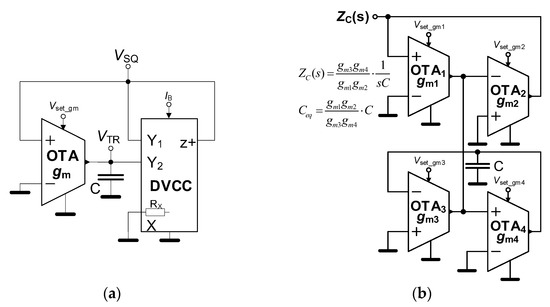
Figure 3.
First proposed simple topology of the triangular and square wave generator: (a) circuit solution, (b) possible solution of the active capacitor having large value integrable on chip.
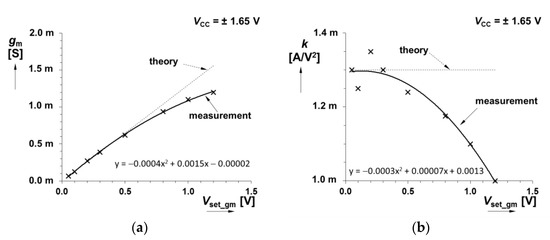
Figure 4.
Nonlinearity of OTA (CMOS MLT) adjustment: (a) real dependence of gm on Vset_gm for Vset_gm larger than 0.5 V, (b) real dependence of k on Vset_gm for Vset_gm larger than 0.5 V.
Numerical results of this equation (called as “estimated”) are now plotted in Figure 5 together with experimental and ideal results and follows real behavior of the circuit.
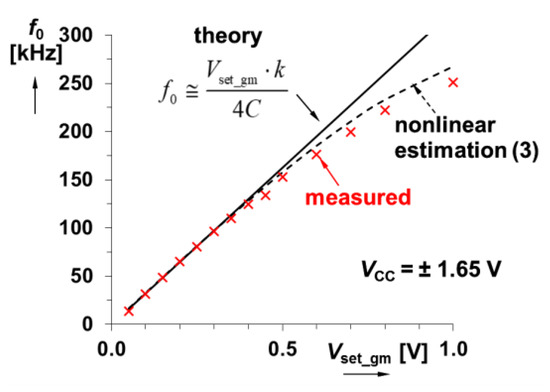
Figure 5.
Dependence of f0 on Vset_gm of first proposed single-parameter controllable generator.
The relative sensitivity (nondimensional) of the repeating frequency f0 on parameters of (2) are: Sr_f0Vset_gm = ∂f0/∂Vset_gm · Vset_gm/f0 = 1 and Sr_f0C = ∂f0/∂C · C/f0 = − 1. These results mean that 1% change of parameter causes 1% change (sign ± indicates direction of change) of the targeted parameter (f0 in our case). These values are typical for similar types of circuits and their respective expressions defining the repeating frequency.
The circuit in Figure 3 was designed with the following values of parameters: C = 1 nF, RX = 450 Ω (IB = 100 µA), while Vset_gm varied from 0.05 V up to 1 V. This design fits the band of tens and hundreds of kHz that represents intended operational ranges of fabricated device [29] (units of MHz expected for linear applications). Note that OTA employs CMOS MLT (Figure 1a). Theoretically expected tunability of f0 defined by (2) yields 16 kHz → 325 kHz. The experimentally obtained dependence of f0 on Vset_gm was gained to be between 13 kHz and 251 kHz as shown in Figure 5. The deviation of measured points from the theoretical trace is given by real effects (Equation (3)) described below equation (2). This nonlinearity causes a deviation of gm value that is not directly proportional to the value of Vset_gm above 0.5 V, but the gm value still rises. Slew-rate limitation and the limited speed of the comparator part contribute as well. The time domain responses of output waveforms are shown in Figure 6 for Vset_gm = 1 V (f0 = 251 kHz). The overall power consumption 43 mW was obtained at supply voltage ±1.65 V. The experimental setup used in both measurements of the proposed generators is shown in Appendix B.
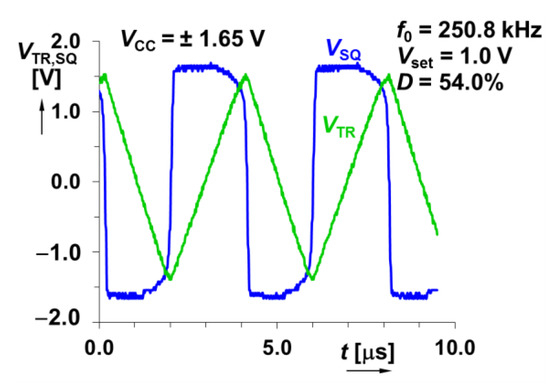
Figure 6.
Examples of output waveforms in time domain for Vset_gm = 1.0 V.
We tested the complete generator (example from Figure 3) for process, voltage and temperature variation (PVT) and reached the following results. The frequency varies in the corner simulation between 136 and 192 kHz (nominal 172 kHz for Vset_gm = 0.5 V), i.e., it is variation about 20%. The variation of the duty cycle was also within 20%. The temperature variation (between 10 and 60 °C) causes smaller deviation from nominal value (between 147 and 189 kHz, i.e., less than 15%). This temperature range was selected as the most typical for usage of the device and its applications operating close to room temperature 20–30 °C. The duty cycle is almost not affected. Note that these results are worst case (the most pessimistic). The supply voltage variation influences bias conditions and should not be lower than ±1.5 V (frequency variation 30%).
The CMOS process usually limits fabricated value of passive capacitor up to several tens of pF. However, we should consider also so-called capacitance multipliers [30,31]. Such devices (generally called also as impedance converter) are able to form very large values of capacities by utilization of active devices. For instance, these circuits use OTAs and small grounded capacitor as in [30] or feedback chain of OTAs and current conveyor together with small floating capacitor as shown in [31] and as shown in Figure 3b. Definitions are described directly in Figure 3b. This solution ensures complete on-chip integration of the system even when large values of capacitors are required. The equivalent capacity Ceq can be obtained as original capacity C multiplied by parameters gm1⋅gm2/(gm3⋅gm4) [30]. Note that values of gm1 = gm2 = 500 µS and gm3 = gm4 = 15 µS (these values are standardly available in many CMOS processes) leads to Ceq ≅ 1 nF from C = 1 pF [30]. The bandwidth of the capacitance multiplier (based on MLTs/OTAs) has sufficiently high value regarding the expected operational range of proposed generator. The acceptable (for integration) capacity value can be selected even larger (10, 100 pF). Then the multiplication factor can be decreased to 100, 10 and effects of additional parasitic capacitances of the chip substrate (in parallel with this capacity), causing possible inaccuracies, are suppressed significantly. Even the ratio of gms (Figure 3b) will be lower as well as it increases the bandwidth of functionality of the capacitance multiplier. The impact of the decreasing quality factor of capacitor may influence the accuracy of frequency about 5% as the maximum (the duty cycle insignificantly).
3.2. Resistor-Less Generator Using Current Controlled Current Conveyor of Second Generation-Based Integrator and OTA-Based Schmitt Trigger
The second solution is shown in Figure 7. When compared to Figure 3 active blocks are interchanged. The comparator is now solved by OTA and the integrator by CCCII i.e., DVCC. The integrator was constructed from CCCII cell that allows RX adjusting by IB current and Schmitt trigger by simple OTA cell (as widely used in standard solutions [4]) based now on BJT MLT (see Section 2). The behavior is significantly different than the previous type of Schmitt trigger as shown in real results. The maximal current of the OTA is limited by RX (IB), then we can write: ISQ = VSQ/RX. The threshold voltages (i.e., amplitude of VTR) of the comparator can be found as:

Figure 7.
Second proposed topology of the generator (reverse order of building blocks in comparison to Figure 3).
The change of the voltage drop across the C can be expressed in general form also by (1). However, ICmax current charging C is defined differently than in previous case. This current ICmax is given by the bias current IB and the current gain of the internal CMOS mirror in the biasing of the differential pair topology of CCCII [29]. Our CCCII provides ICmax = 10∙IB. Then, we can write the final form (with help of (4)) for repeating frequency as:
that can be modified (in accordance to empirical equation for RX = f(IB) ≅ 0.317 · IB−0.8 [Ω, A]) as:
We can see that IB also modifies the relation between VTR and VSQ. Therefore, increasing IB causes a decrease in the VTR output level in direction to higher frequencies (f0).
The maximal available gm of BJT MLT for Vset_gm = 1 V reaches approximately 3.3 mS, but dependence of gm on Vset_gm is highly nonlinear and asymmetrical (linearity ensured up to 0.5 V). The numerical parameters of this design are C = 1 nF and Vset_gm = 1 V. Note that BJT MLT (Figure 1a) now serves as an OTA-based comparator. Dependence of f0 on driving current IB is shown in Figure 8. The range of tunability for IB adjusted from 5 µA up to 140 µA allows a theoretical change of f0 from 8 kHz up to 1010 kHz. Experimentally obtained results indicated tunability between 12.2 kHz and 847 kHz. The grounded terminal Y of the CCCII may serve for duty cycle adjustment if DC voltage is connected at this terminal (similarly as in [16]). The example of output waveforms in time domain (Figure 9) confirms expected behavior (IB = 50 µA for f0 = 137 kHz). Dependence of the output levels of generated signals on f0 in Figure 9b confirms the discussed theoretical influence of IB on the triangular waveform (decreasing trend). The maximal power consumption reaches 41 mW. The BJT MLT has almost constant power consumption, approximately 10 mW, but the CCCII needs a majority of the total power consumption. The power consumption of the generator is variable (based especially on the current IB value) from approximately 30 mW up to 41 mW.
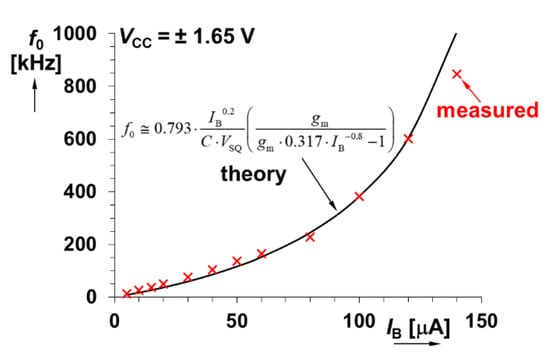
Figure 8.
Dependence of f0 on IB of second proposed single-parameter controllable generator.
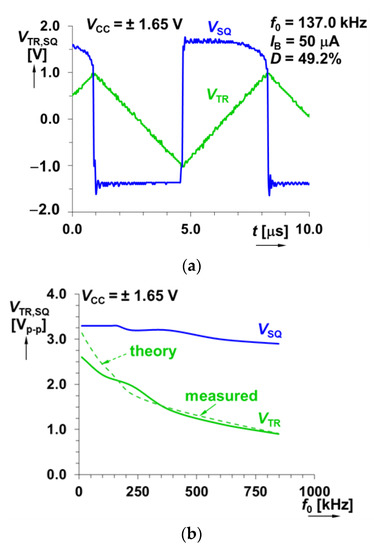
Figure 9.
Time domain analysis: (a) output waveforms example for IB = 50 µA, (b) dependence of generated waveform levels on f0.
The relative sensitivities of the repeating frequency f0 on parameters from (5) are Sr_f0C = ∂f0/∂C · C/f0 = − 1, Sr_f0VSQ = ∂f0/∂VSQ · VSQ/f0 = − 1. The sensitivity on gm reaches Sr_f0gm = ∂f0/∂gm · gm/f0 = − 1/(RX⋅gm − 1) ≅ − 1/(0.317⋅IB−0.8⋅gm − 1). The sensitivity of f0 on RX has the following form Sr_f0gm = Sr_f0RX. Considering maximal available voltage amplitude of VSQ = 1.65 V (saturation of the output equal to ±1.65 V) and design parameters noted above, the numerical values are between −0.06 and −3.75 when IB varied between 5 µA and 140 µA (as indicated above for tunability purposes). It means that f0 is more sensitive on fluctuations of gm when IB is higher. Fortunately, when gm · RX >> 1 (see right part of (5)), the whole term in parenthesis goes close to 1 (and generated waveforms have identical amplitude as well). This fact is determined by the performance of used active elements. Increasing the value of gm causes a lower sensitivity range (gm = 10 mS and the same range of IB yields sensitivity from −0.02 to −0.35). The sensitivity on IB theoretically reaches Sr_f0IB = ∂f0/∂IB · IB/f0 = 1. However, the RX value is also influenced by IB, therefore Sr_f0IB = ∂f0/∂IB · IB/f0 ≅ (317 · gm − 200 · IB0.8)/(317 ⋅ gm − 1000 · IB0.8). The numerical value of sensitivity varies between 1.05 and 4.00 (for 5 µA and 140 µA). This impact on the value of the repeating frequency is significant and very useful, because a higher value of IB increases sensitivity of f0 on its value. We can observe this behavior in Figure 8. It supports the initial idea about possible tunability extension and it represents an interesting conclusion for further methodologies of tunability control. Therefore, this paper has a theoretical (mathematic) impact observable in specific circuitry and it has important practical consequences. The first circuit (Figure 3) has a novel character of topology too, but standard tunable properties (linear) useful for comparison purposes (see Table 2). Moreover, the second circuit (Figure 7) also shows interesting consequences of special (untypical) expression for the repeating frequency on tunability.

Table 2.
Evaluation of experimental performances of both studied solutions.
The nonlinear dependence of the frequency on the DC control current (Figure 8) is an intentional feature of our circuit because of the requirement of tunability range extension in low-voltage designs [32,33]. These features have not been presented in case of the square waveforms before. It is known from sine wave oscillators [32,33]. The nonlinear dependence as presented in our work (Figure 7, Equation (6)) allows a wider range of the frequency adjustability than in case of standard methods.
We set the nominal frequency 136 kHz (IB = 50 mA) and tested corner analysis. The frequency varies between 128 kHz and 158 kHz (15%). The duty has a variation of 10%. The temperature (between 10 and 60 °C) effects do not create significant deviations (less than 1%) in frequency and duty cycle. There is an impact on the triangular wave level (but expected as discussed in theory). The supply voltage variation has a less significant effect then in the previous case. The frequency variation is up to 30% maximally for supply no lower than ±1.4 V. The duty cycle is not influenced.
4. Comparison of Both Solutions
Table 2 summarizes features of both proposed solutions under very similar conditions. The voltage controlled f0 in solution presented in Figure 3 brings significant simplification for driving system (microprocessor, digital to analog converter—DAC) because the generators can be tuned directly from driving system without any additional complex active circuitry as in case of operational amplifier-based solutions (tuned by the active replacement of resistor(s)). However, nonlinearity of dependence of gm on Vset_gm (especially for Vset_gm > 0.5 V) causes a decrease in the tunable range of f0 in comparison to the theory (deviation from linear dependence) as evident from Figure 5. The second solution (Figure 7) seems to be significantly better in range of f0 readjustment by DC bias current IB despite nonlinear dependence of RX on IB. However, the voltage to current conversion must be implemented (transforming resistor) for direct driving from common systems. Number of passive elements is similar in both solutions. In fact, both circuits require only one grounded capacitor. Nevertheless, significant difference of both concepts can be found in number of integrated parts (cells) of IC. The first solution (Figure 3) requires tree cells and second solution (Figure 7) only two. Level of output waveform of VSQ output (Figure 3) reaches almost supply voltage (due to type of used Schmitt comparator—no sink for output current of the DVCC) but the second case of the Schmitt trigger (Figure 7) supplies integrator block by current flowing from OTA output to the X terminal of CCCII. Therefore, principal dependence of VTR level (given by product of gm∙RX) is evident when RX is used for f0 tuning. The second circuit (Figure 7) seems to be more suitable for high-speed operations than the first circuit (Figure 3) because the comparator output has quite low-impedance (direct connection of RX) in comparison to the high impedance node of DVCC-based solution of Schmitt trigger in Figure 3. Then, the parasitic capacities in nodes have a not so significant impact as in the case of high-impedance nodes.
As the conclusion of this discussion, we can observe that the change of number of active or passive elements cannot guarantee obtainment of high-quality solutions. Parameters other than complexity should be more important than differences in the amount of elements in circuit topologies. Nevertheless, both solutions are suitable for appropriate application based on particular requirements.
5. Conclusions
We proposed and designed two electronically tunable solutions of the triangular and square wave generator of similar complexity employing active subparts (cells) available in single IC package fabricated in I3T 0.35 µm ON Semiconductor technology. Both solutions are designed for operation over one decade of repeating frequency from 13 kHz (12 kHz, respectively) up to more than 250 kHz. Detailed analysis of obtained features and their comparison predetermines the first type (Figure 3) for simple linear voltage control from driving system. It is worth to use this generator (Figure 3) in applications below 1 MHz otherwise parasitic features start to be important sources of inaccuracies. The approximate value of 1 MHz is taken as the maximal frequency, where circuit in Figure 3 works. This maximal available frequency was tested with C = 100 pF, but dependences cannot be considered as accurate and operation as reliable because of waveform shapes degradation and invalidity of determined equations due to complex effects (limited slew-rate, nonlinearities, parasitic effects, etc.) acting together that are not analytically describable. This also includes high deviation of theoretically expected and real dependence of the frequency on the driving voltage. Similarly, the control voltage Vset_gm should be used up to 0.5 V (limitation of designed and fabricated cell [29]) when strictly linear dependence of repeating frequency on the driving voltage is required. Similar consideration is valid for the second solution of the generator (Ib approximately up to 120 µA in designed specification). The second solution (Figure 7) indicates better features than the circuit in Figure 3 also for higher frequency bands (no significant effects of parasitic features influencing integrator—value of C, or comparator) and nonlinear tuning of repeating frequency in wide range. Significantly wider range of f0 readjustment than in the first solution results from nonlinear dependence of f0 on IB). However, nonlinear bias current (IB) adjustment of RX is not common method that can be immediately used by peripheral devices (microcontroller, DAC, etc.) because additional voltage to current converter should be used in advance. Based on comparison with known solutions in literature (Table 1), both proposed generators offer beneficial features. The dependence of triangular-wave amplitude on tuning process (Figure 7) does not mean significant issue because square-wave outputs are used much more frequently than triangular waveforms in standard mixed-mode systems especially, i.e., extension of frequency tunability range of square-wave can be found as important advantage. Special concepts of active elements (carbon nanotube FET based devices) have been reported quite recently also in the design of waveform generators [34]. However, the example presented in [34] is not utilizing the full potential of electronic adjustability so far (tuning by value of resistor only) and the resulting circuitry is complex. The complexity consists in three active and nine passive elements used for construction of generator of the triangular and square waveforms.
The general application field of square wave generators can be found in the circuit testing (wideband signal of various frequency), digital systems (clock), signal processing and sensing systems (phase locked loops, modulators and demodulators) [5,12,32,33], etc. The presented structures can be directly used, for example, in the measuring and sensing systems for the signal transmission reported in [35,36]. The applications of presented tunability methods are useful for wideband readjustment of the frequency over a large band because decreasing the supply voltage and the voltage used for adjustment is limited [32,33]. These issues are solved by the nonlinear exponential dependence of the frequency on the driving parameter [32] or power of the driving parameter [33]. As observed for the second solution (Figure 7), the increased sensitivity of the key parameter for the frequency tuning results in extended tunability range that was not reported before.
Author Contributions
Conceptualization, R.S. and J.J.; Methodology, R.S.; Validation, R.S. and J.J.; Formal analysis, J.J.; Investigation, R.S.; Data curation, J.J.; Writing—original draft preparation, R.S.; Writing—review and editing, R.S. and J.J.; Visualization, R.S.; Supervision, J.J. All authors have read and agreed to the published version of the manuscript.
Funding
This work was supported by the Internal Grant of Brno University of Technology underproject FEKT-S-20-6361.
Data Availability Statement
Not applicable.
Conflicts of Interest
The authors declare no conflict of interest. The funders had no role in the design of the study; in the collection, analyses, or interpretation of data; in the writing of the manuscript; or in the decision to publish the results.
Appendix A
Topologies of used active elements (cells) fabricated in I3T25 0.35 µm CMOS process (ON Semiconductor) [29]. Based on standard industrial requirements, all bulks are connected to VSS for NMOS and to VDD for PMOS.
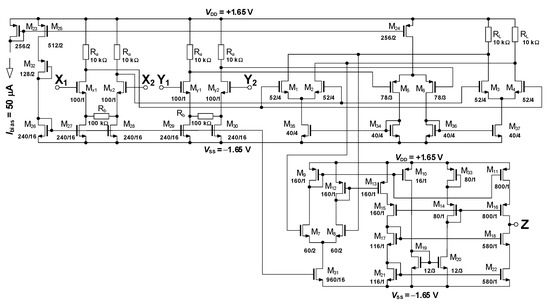
Figure A1.
CMOS MLT internal structure with transistor dimensions (W/L) and other parameters included directly within the figure [29].

Figure A2.
BJT MLT internal structure [29].
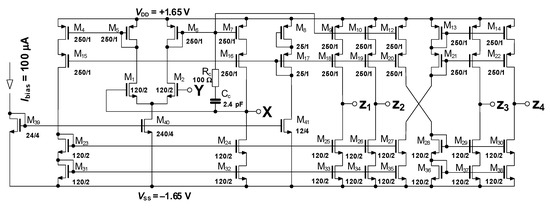
Figure A3.
CMOS CCCII internal structure [29].

Figure A4.
CMOS VDDB internal structure [29].
Appendix B
The experimental setup for measurement of the presented features uses a special printed circuit board with socket for fabricated IC package and auxiliary circuits (buffers, amplifiers, terminators, variable DC voltage and current sources) for designed tests. Keysight DSO-X 3024T oscilloscope has been selected for measurement of output signals of proposed generators. The testing board includes standard discrete elements for power sourcing (regulators LM317, LM337), amplifiers and buffers (OPA2652, LT1364), current to voltage and voltage to current transformers using diamond transistors (OPA860), trimers for generation of continuous voltage/current adjustment, biasing, etc. All external interconnections were created by jumpers.
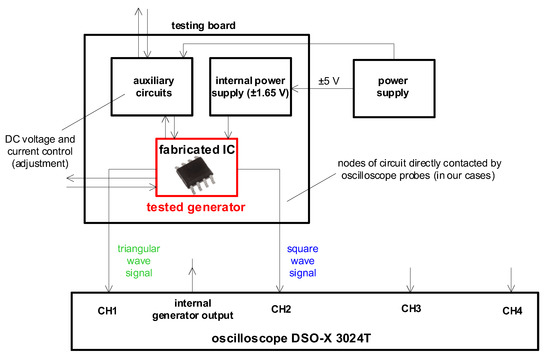
Figure A5.
Experimental setup used for the measurement of the presented features and parameters of circuits.

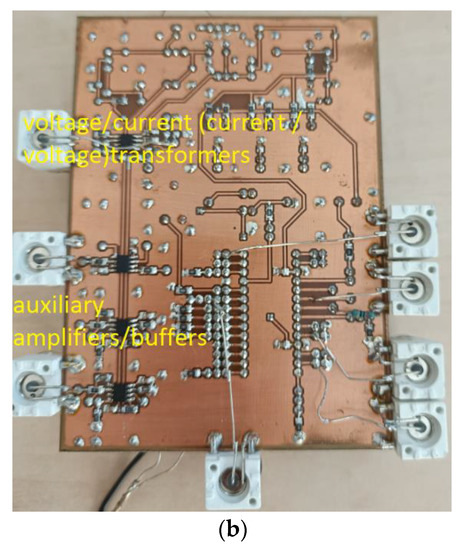
Figure A6.
Photograph of the experimental testing board: (a) top, (b) bottom.
References
- Senani, R.; Bhaskar, D.R.; Singh, V.K.; Sharma, R.K. Sinusoidal Oscillators and Waveform Generators Using Modern Electronic Circuit Building Blocks; Springer International Publishing AG: Cham, Switzerland; Berlin, Germany, 2016; pp. 1–622. ISBN 978-3-319-23712-1. [Google Scholar] [CrossRef]
- Biolek, D.; Senani, R.; Biolkova, V.; Kolka, Z. Active elements for analog signal processing: Classification, Review and New Proposals. Radioengineering 2008, 17, 15–32. [Google Scholar]
- Senani, R.; Bhaskar, D.R.; Singh, A.K. Current Conveyors: Variants, Applications and Hardware Implementations; Springer International Publishing: Cham, Switzerland; Berlin, Germany, 2015; pp. 1–560. ISBN 978-3-319-08683-5. [Google Scholar] [CrossRef]
- Chung, W.S.; Kim, H.; Cha, H.-W.; Kim, H.-J. Triangular/square-wave generator with independently controllable frequency and amplitude. IEEE Trans. Instrum. Meas. 2005, 54, 105–109. [Google Scholar] [CrossRef]
- Siripruchyanun, M.; Wardkein, P. A full independently adjustable, integrable simple current controlled oscillator and derivative PWM signal generator. IEICE Trans. Fundam. Electron. Commun. Comput. Sci. 2003, 86, 3119–3126. [Google Scholar]
- Kumbun, J.; Siripruchyanun, M. MO-CTTA-based electronically controlled current-mode square/triangular wave generator. In Proceedings of the 1st International Conference on Technical Education (ICTE2009), Bangkok, Thailand, 21–22 January 2010; pp. 158–162. [Google Scholar]
- Silapan, P.; Siripruchyanun, M. Fully and electronically controllable current-mode Schmitt triggers employing only single MO-CCCDTA and their applications. Analog. Integr. Circuits Signal Process. 2011, 68, 111–128. [Google Scholar] [CrossRef]
- Srisakul, T.; Silapan, P.; Siripruchyanun, M. An electronically controlled current-mode triangular/square wave generator employing MO-CCCCTAs. In Proceedings of the 8th International Conference on Electrical Engineering/Electronics, Computer, Telecommunications, and Information Technology, Khon Kaen, Thailand, 17–19 May 2011; pp. 82–85. [Google Scholar]
- Janecek, M.; Kubanek, D.; Vrba, K. Voltage-Controlled Square/Triangular Wave Generator with Current Conveyors and Switching Diodes. Int. J. Adv. Telecommun. Electrotech. Signals Syst. 2012, 1, 76–79. [Google Scholar]
- Sotner, R.; Jerabek, J.; Herencsar, N. Voltage Differencing Buffered/Inverted Amplifiers and Their Applications for Signal Generation. Radioengineering 2013, 22, 490–504. [Google Scholar]
- Sotner, R.; Jerabek, J.; Herencsar, N.; Dostal, T.; Vrba, K. Design of Z-copy controlled-gain voltage differencing current conveyor based adjustable functional generator. Microelectron. J. 2015, 46, 143–152. [Google Scholar] [CrossRef]
- Jerabek, J.; Sotner, R.; Dostal, T.; Vrba, K. Simple Resistor-less Generator Utilizing Z-copy Controlled Gain Voltage Differencing Current Conveyor for PWM Generation. Elektron. Elektrotechnika 2015, 21, 28–34. [Google Scholar]
- Sotner, R.; Petrzela, J.; Jerabek, J.; Domansky, O.; Langhammer, L. Special Electronically Reconfigurable Lossy/Lossless Integrator in Application of Functional Generator. In Proceedings of the 27th International Conference Radioelektronika, Brno, Czech Republic, 19–20 April 2017; pp. 1–5. [Google Scholar]
- Sotner, R.; Jerabek, J.; Herencsar, N.; Prokop, R.; Vrba, K.; Petrzela, J.; Dostal, T. Simply Adjustable Triangular and Square Wave Generator Employing Controlled Gain Current and Differential Voltage Amplifier. In Proceedings of the 23th International Conference Radioelektronika, Pardubice, Czech Republic, 16–17 April 2013; pp. 109–114. [Google Scholar]
- Sotner, R.; Jerabek, J.; Herencsar, N.; Lahiri, A.; Petrzela, J.; Vrba, K. Practical Aspects of Operation of Simple Triangular and Square Wave Generator Employing Diamond Transistor and Controllable Amplifiers. In Proceedings of the 36th International Conference on Telecommunications and Signal Processing (TSP2013), Rome, Italy, 2–4 July 2013; pp. 431–435. [Google Scholar]
- Sotner, R.; Jerabek, J.; Herencsar, N. Study of impact of voltage gain of comparator on performance of newly designed functional generator. Opt. Int. J. Light Electron Opt. 2018, 172, 203–219. [Google Scholar] [CrossRef]
- Chaturvedi, B.; Kumar, A. A novel linear square/triangular wave generator with tunable duty cycle. AEU Int. J. Electron. Commun. 2018, 84, 206–209. [Google Scholar] [CrossRef]
- Kumar, A.; Chaturvedi, B. Single Active Element-Based Tunable Square/Triangular Wave Generator with Grounded Passive Components. Circuits Syst. Signal Process. 2017, 36, 3875–3900. [Google Scholar] [CrossRef]
- Siripruchyanun, M.; Payakkakul, K.; Pipatthitikorn, P.; Satthaphol, P. A Current-mode Square/Triangular ware Generator based on Multiple-output VDTAs. Procedia Comput. Sci. 2016, 86, 152–155. [Google Scholar] [CrossRef][Green Version]
- Chaturvedi, B.; Kumar, A. Fully Electronically Tunable and Easily Cascadable Square/Triangular Wave Generator with Duty Cycle Adjustment. J. Circuits Syst. Comput. 2019, 28, 1950105. [Google Scholar] [CrossRef]
- Kumar, A.; Chaturvedi, B.; Maheshwari, S. A fully electronically controllable Schmitt trigger and duty cycle-modulated waveform generator. Int. J. Circuit Theory Appl. 2017, 45, 2157–2180. [Google Scholar] [CrossRef]
- Sacu, I.E. An Electronically Adjustable Waveform Generator. J. Circuits Syst. Comput. 2020, 29, 2050191. [Google Scholar] [CrossRef]
- Thanyaratsakul, N.; Tanthong, A.; Tritummanurak, T.; Keaw-on, R.; Paponpen, K.; Silapan, P.; Jaikla, W. Single LT1228 Based Electronically Controllable Sawtooth Generator. In Proceedings of the 9th International Electrical Engineering Congress (iEECON), Pattaya, Thailand, 10–12 March 2021; pp. 349–352. [Google Scholar]
- Siripruchyanun, M.; Hirunporm, J. A fully/electronically controllable voltage-mode Schmitt trigger based on only single VDGA and its applications. AEU Int. J. Electron. Commun. 2021, 131, 153602. [Google Scholar] [CrossRef]
- Kumari, S.; Visweswaran, G.S.; Kumari, L. Design and Analysis of Voltage Control Function Generator Using Highly Linear CCII. In Proceedings of the 17th India Council International Conference (INDICON), New Delhi, India, 10–13 December 2020; pp. 1–6. [Google Scholar]
- Chaturvedi, B.; Kumar, A. CMOS MO-CFDITA Based Fully Electronically Controlled Square/Triangular Wave Generator with Adjustable Duty Cycle. IET Circuits Devices Syst. 2018, 12, 817–826. [Google Scholar] [CrossRef]
- Prokop, R.; Musil, V. Modular approach to design of modern circuit blocks for current signal processing and new device CCTA. In Proceedings of the 7th International Conference on Signal and Image Processing, Honolulu, HI, USA, 15–17 August 2005; pp. 494–499. [Google Scholar]
- Prokop, R.; Musil, V. New modular current devices for true current mode signal processing. Electronics 2007, 16, 36–42. [Google Scholar]
- Sotner, R.; Jerabek, J.; Polak, L.; Prokop, R.; Kledrowetz, V. Integrated Building Cells for a Simple Modular Design of Electronic Circuits with Reduced External Complexity: Performance, Active Element Assembly, and an Application Example. Electronics 2019, 8, 568. [Google Scholar] [CrossRef]
- Geiger, R.L.; Sanchez-Sinencio, E. Active filter design using operational transconductance amplifiers: A tutorial. IEEE Circuits Devices Mag. 1985, 1, 20–32. [Google Scholar] [CrossRef]
- Al-Absi, M.A.; Al-Khulaifi, A.A. A New Floating and Tunable Capacitance Multiplier with Large Multiplication Factor. IEEE Access 2019, 7, 120076–120081. [Google Scholar] [CrossRef]
- Sotner, R.; Jerabek, J.; Petrzela, J.; Domansky, O.; Jaikla, W.; Dostal, T. Exponentially tunable voltage controlled quadrature oscillator. In Proceedings of the 40th International Conference on Telecommunications and Signal Processing (TSP), Barcelona, Spain, 5–7 July 2017; pp. 302–306. [Google Scholar]
- Sotner, R.; Jerabek, J.; Herencsar, N.; Petrzela, J. Methods for Extended Tunability in Quadrature Oscillators Based on Enhanced Electronic Control of Time Constants. IEEE Trans. Instrum. Meas. 2018, 67, 1495–1505. [Google Scholar] [CrossRef]
- Jogad, S.; Loan, S.A.; Afzal, N.; Alharbi, A.G. CNTFET based class AB current conveyor II: Design, analysis and waveform generator applications. Int. J. Numer. Modelling Electron. Netw. Devices Fields 2020, 34, e2783. [Google Scholar] [CrossRef]
- Sotner, R.; Jerabek, J.; Polak, L.; Petrzela, J.; Jaikla, W.; Tuntrakool, S. Illuminance Sensing in Agriculture Applications Based on Infra-Red Short-Range Compact Transmitter Using 0.35 um CMOS Active Device. IEEE Access 2020, 8, 18149–18161. [Google Scholar] [CrossRef]
- Sotner, R.; Jerabek, J.; Polak, L.; Prokop, R.; Kledrowetz, V.; Theumer, R.; Langhammer, L. Special analog multipliers in voltage-controlled oscillator and phase-locked loop-based FM demodulator for measurement and processing of sensed low-frequency signals. Measurement 2022, 201, 111734. [Google Scholar] [CrossRef]
Publisher’s Note: MDPI stays neutral with regard to jurisdictional claims in published maps and institutional affiliations. |
© 2022 by the authors. Licensee MDPI, Basel, Switzerland. This article is an open access article distributed under the terms and conditions of the Creative Commons Attribution (CC BY) license (https://creativecommons.org/licenses/by/4.0/).